|
What are Modes?
What is Mode 2 or the X-Mode? and what is Mode 5 or the Ring-Mode? Here are the ‘tea leaf' patterns that show up when the plates are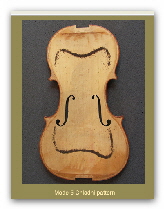 vibrated using a loudspeaker underneath at a particular frequency - the ‘tap tone'. It is a resonant frequency of the plate as a whole. vibrated using a loudspeaker underneath at a particular frequency - the ‘tap tone'. It is a resonant frequency of the plate as a whole.
On the left here is one of the excellent photos on Joseph Curtin's website and shows the most important Mode in a belly plate, Mode 5, the ring tone. The black lines are the nodal lines on a violin belly vibrating in Mode 5 at about 350 Hz. The pictures below show Mode 2 in a front plate at about 170 Hz. Have a look too at a BBC web page here that uses “holographic interferometry” (!) to do the same thing - only even better!
These pictures show that when a plate, either the front or back of an instrument is vibrated at one constant frequency then fine sand, tea leaves, sawdust or glitter placed on it will move to areas of the plate that are not moving i.e. not vibrating. This only happens at particular resonan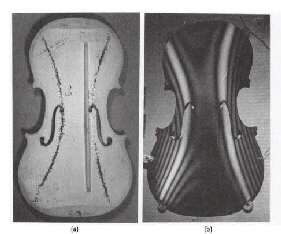 t frequencies, and finding those resonant frequencies is what this is all about. These lines of no motion are called the ‘nodes', or in this case the ‘nodal lines'. Anti-nodes are where the motion is at a maximum. t frequencies, and finding those resonant frequencies is what this is all about. These lines of no motion are called the ‘nodes', or in this case the ‘nodal lines'. Anti-nodes are where the motion is at a maximum.
In summary: The “nodal lines” are the black lines in the photos and videos where the plate does not vibrate at that particular frequency. So the plate can and must be held somewhere on a nodal line without affecting th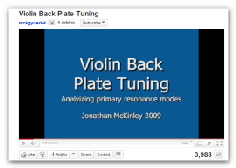 e vibrating pattern of that Mode. e vibrating pattern of that Mode.
There is a good YouTube video by Jonathan McKinley (click on the picture left) that clearly shows plate modes 1, 2 and 5 vibrating as the tea leaves migrate to the lines of zero-vibration - the nodal lines of the violin plate as the vibrating frequency is gradually increased. Jonathan McKinley has photographed his violin parts here too: but his belly: Mode 2 is high, and Mode 5 low!
Understanding these 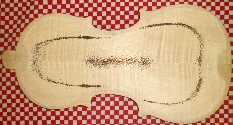 Modes and their shapes is fundamental to understanding tap tones. You will need to know how to get these Modes vibrating. It was Carleen who first used a speaker placed under a plate at an anti-node, and fed the ‘speaker at various frequencies until a glitter pattern showed up. Modes and their shapes is fundamental to understanding tap tones. You will need to know how to get these Modes vibrating. It was Carleen who first used a speaker placed under a plate at an anti-node, and fed the ‘speaker at various frequencies until a glitter pattern showed up.
These patterns are well illustrated by other website pages to be found in the “Really Useful Links” page.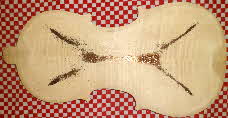 If you click on either these two glitter patterns you can see the nodal lines on a back plate that Alan Jhones from Brazil sent me (thanks!). Mode 5 is the one above, and Mode 2 is on the right. If you click on either these two glitter patterns you can see the nodal lines on a back plate that Alan Jhones from Brazil sent me (thanks!). Mode 5 is the one above, and Mode 2 is on the right.
We can also get the plates vibrating by holding at a point on a nodal line, and tapping at an ‘anti-node', or a point where the vibration is or will be a maximum: it works well, but there is information lost about the detailed shape of the nodal lines: Carleeen thought that is important.
Animations of plates vibrating
Borman Violins also shows some excellent and fascinating animations of violin and other plates here vibrating in situ on a violin and viola, made possible by the work of instrument maker George Stoppani.
This helps us understand how the vibration of the belly and back plates vibration modes while free (as we measure them) are linked to how they behave actually in a completed instrument.
Vibration modes of the completed violin
Getting the tap tones right for the plates will give you a good chance that the resonance modes of the completed violin body will be right - or at least similar to the world's greatest violins! Have a look here for the resonances of the completed violin body ......
...but what tap tones don't tell us
Well you wont make a violin that sounds like a £15,000 violin using tap tones like this unless you are very, very, very, very lucky and at least prepared to let an expert choose the (costly) wood to start with.
There is another and much higher level of the art, experience (and science) that the master craftsman has that us mere mortals can only dream of.
You can glimpse some of it in the work some are doing to actually listen openly to what violins sound like: there's a discussion here on maestronet for instance, which I've edited to a .pdf document here to make more of a narrative (and remove the occasional name calling these forums suffer from).
Others for instance have tried area tuning ( see this fascinating site of Keith Hill's) and ‘Vigdorchik strip' tap tuning (see David Langsather's example here) which I think has great possibilities, but you will need a lot of faith, patience, and a very, very good ear to do it. And much of a lifetime.
|
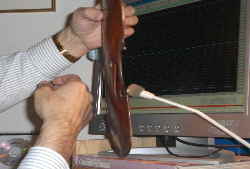
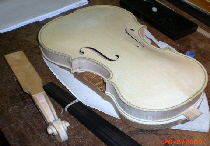


 t frequencies, and finding those resonant frequencies is what this is all about. These lines of no motion are called the ‘nodes', or in this case the ‘nodal lines'. Anti-nodes are where the motion is at a maximum.
t frequencies, and finding those resonant frequencies is what this is all about. These lines of no motion are called the ‘nodes', or in this case the ‘nodal lines'. Anti-nodes are where the motion is at a maximum.
